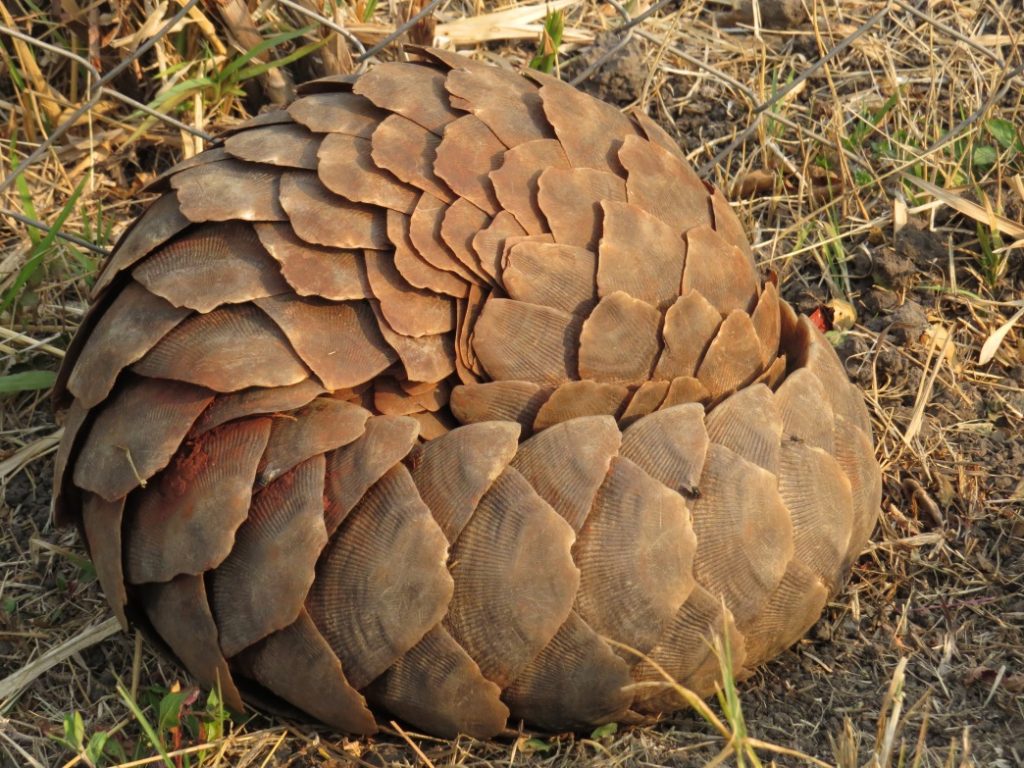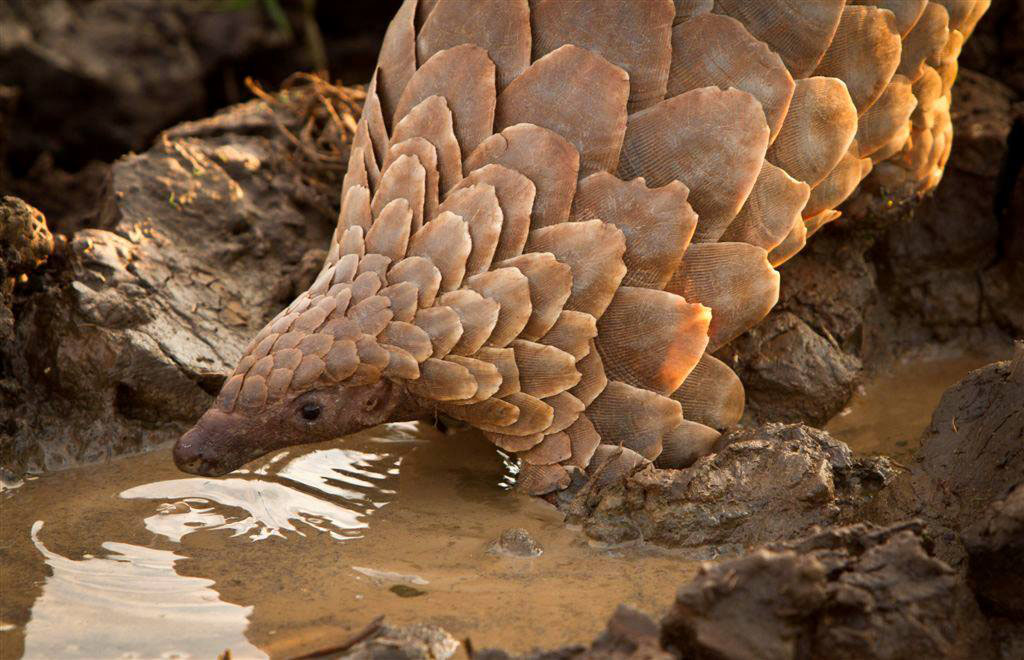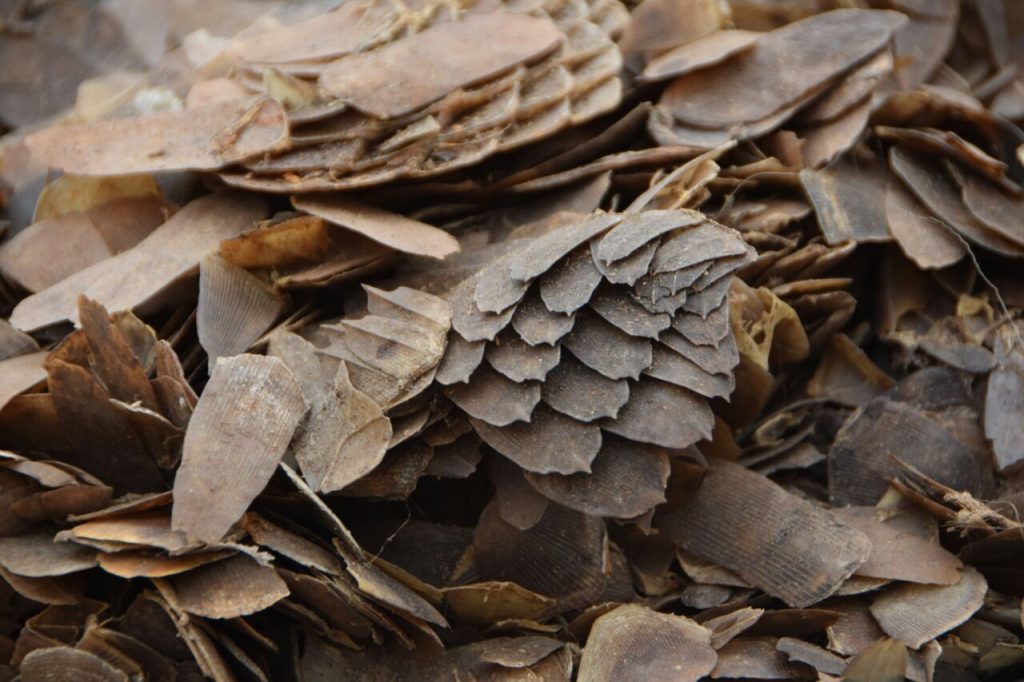My favourite animal changes all the time. When I was younger, I cycled through various large, majestic cats such as tigers, jaguars and snow leopards. At one point, I considered the polar bear among my favourites; another time, the hippo. But now I much prefer stranger, more obscure, more underappreciated animals. And a weird, elusive, nocturnal creature that looks almost like a walking pinecone fits that bill perfectly – the pangolin.
Pangolins are scaly enigmas that fascinate people of all ages. All species face imminent extinction from #Chinese #medicine, the #pet trade and #deforestation. Join the #Boycott4Wildlife and halt deforestation. By @thenaturenook
Tweet
For many people, the first time they heard about this animal was probably in very recent months when it was identified as a possible culprit in transmitting COVID-19 from its original hosts (thought to be horseshoe bats) to humans. For better or worse, this recognition has brought the pangolin into mainstream media.
But even before the pangolin attracted global attention for its potential role in the pandemic that still grips the world, many conservationists had already been focusing on this strange, scaly creature for many years. And that’s because it has the dubious honour of being the most trafficked (non-human) mammal in the world.
Scaly Enigmas

Image Source: Tikki Hywood Trust via U.S. Fish and Wildlife Service Headquarters
There are only two groups of armoured mammals alive today. In the Americas, there are 21 species of armadillo, two of which can roll up into virtually impregnable balls to defend themselves. And on the other side of the world, in Africa and Asia, there are eight species of pangolin, which, although superficially similar in appearance to the armadillos, are not closely related to them at all.
Whereas armadillos are mainly protected by plates of dermal bone, the pangolin, uniquely among mammals, is almost completely covered in large brown scales made out of keratin (the same substance our hair and nails are made from). These scales overlap like shingles on a roof to create an almost impenetrable layer of armour that very few predators can overcome. The pangolin can even erect its scales and shut them like powerful scissors, chopping off anything that pokes between them, including, it is said, human fingers. As the scales wear out, they are replaced, one by one, so that a pangolin has the same number throughout its life.
The only places on a pangolin’s body not protected by scales are the sides of its face, the tip of its snout, and its belly and throat, which are naked except for a few fine, sparse hairs. If it feels threatened, it tucks its head towards its belly and wraps itself into a ball with its thick, muscular tail clasped tightly around itself. In fact, the name pangolin comes from the Malay word pengguling, which means ‘one who rolls up’.
Pangolins have both fascinated and confused Europeans for hundreds of years. These animals seemed to have a hybrid quality about them – part reptile, part mammal, and with just a little hint of fish. In the 17th century, the strange scaly skins of pangolins arrived in Europe more often than the living animals, although they were usually simply labelled as ‘scaly Indian lizards’.

Pangolins may look a bit like scaly anteaters, but their closest relatives are in the order Carnivora, which includes dogs, cats, hyenas, bears and seals. Of the eight species of pangolin, four live in Africa and four in Asia. Some of the smaller species spend their lives in trees and clamber around with the aid of a long, grasping tail. The smallest, the long-tailed pangolin from Africa, is also the most arboreal; its tail has 46 or 47 vertebrae – the most of any mammal. The larger species, however, are completely ground-dwelling. The front claws of a pangolin are so large that they aren’t much good for walking on, so it either walks on its knuckles or trundles along on its hind legs, hunched over so that its body is almost horizontal, with its front paws raised near the chest as if in prayer.

Image Source: David Brossard
The pangolin’s powerful claws are reserved primarily for digging and ripping open ant and termite nests. Once it has done this, it laps up the insects with a long, sticky tongue. The tongue of the biggest species, the giant pangolin, can reach lengths of up to 40 cm – one of the longest tongues relative to body size of any mammal – and the sheath that houses it extends right down the front of the animal’s chest and connects with its pelvis. The pangolin has no teeth, so ants collected by the mucus on the tongue are swallowed whole and mashed up by the horny lining and muscular movements of the stomach. It may also swallow small stones and sand to further grind up its food.
The Scale of the Problem
Hyenas and big cats can, occasionally, and with some considerable effort, pry a rolled-up pangolin apart. But the armour that normally protects this animal makes it acutely vulnerable to the deadliest predator of all: ourselves. In fact, rolling into a ball simply allows humans to pick it up and carry it off to the cooking pot or a crate with little fuss.
Culinary uses of pangolin range from bushmeat in Africa to delicacies in high-end Asian restaurants. In Vietnam, restaurants can charge up to US$150 per pound of pangolin meat, for it is considered a luxury food. Among Vietnam’s business elite, it is highly-prized as a status symbol, with businessmen frequently ordering pangolin meat to impress visitors. Even in restaurants that specialise in cooking exotic wildlife, pangolins are often the most expensive item on the menu. Sometimes, customers are required to order two hours in advance and place a deposit based on the animal’s weight. Restaurant employees may even kill the pangolin at the table, in front of diners, to show authenticity and freshness.
Ironically, given that they are supposed to protect the animal, it is a pangolin’s scales that make it so valuable in the illegal wildlife trade. These scales are highly sought after in many parts of both Africa and Asia for their purported benefits in traditional medicine, despite the fact that they (like rhino horn) are made only of keratin. They are incorrectly believed to, among other things, improve blood circulation, cure male impotence, stimulate lactation, and treat skin conditions.
The ground pangolin is known as bwana mganga, or ‘the doctor’, in Tanzania because every part of its body is believed to have medicinal use. There is, of course, absolutely no evidence that these scales have any impact on human health, yet the claims made on their behalf seem to become more outlandish by the year. Indeed, their ‘benefits’ have gone beyond the merely medical and can now supposedly ward off evil spirits and confer invisibility.

Image Source: Kenneth Cameron, via the U.S. Fish and Wildlife Service Headquarters
The number of pangolins killed annually is hard to quantify. A conservative figure of 200,000 a year has been given, but that is likely to be an underestimate. Pangolins have been hunted and trafficked so extensively that all eight species are now threatened. Three are perilously close to extinction. The wild population of the Chinese pangolin, in particular, has declined by more than 80% in the last 20 years.
In 2016, CITES (the Convention on International Trade in Endangered Species) granted all eight species of pangolin the strictest form of protection, banning all international commercial trade. However, this has not slowed the increases in illegal killing or highly organised smuggling. Because they are notoriously difficult to keep alive and breed in captivity, and because three of the four Asian species have already been so extensively poached that they are now hard to find, illegal traders have turned to the African species. Pangolins are now being smuggled on an almost industrial scale from Africa to Asia to keep up with demand.
The black market is certainly lucrative: a kilogram of pangolin meat can be worth hundreds of dollars; a kilo of scales thousands of dollars. In 2017, China intercepted a shipment from Africa of nearly 12 tonnes of scales – representing around 30,000 pangolins. And in 2019 alone, authorities seized a staggering 81 tonnes; the average shipment size has increased from 2.2 tonnes three years ago to 6.2 tonnes today. What is most worrying about this is that the majority of the illegal trade goes undetected and unreported, with seizures representing only around a quarter of actual trade.

Image Source: ExonOxon
Hope for the Future?
On 26 January 2020, in an attempt to curb the spread of COVID-19, China slapped a temporary ban on buying, selling and eating wild animal meat, and began shutting down breeding farms across the country. However, this ban does not extend to animals traded for fur, medicine or research. According to the Wildlife Conservation Society, this ‘creates a potential loophole for traffickers who may exploit the non-food exemptions to sell or trade live wildlife’.
In June, China’s state media announced that pangolin scales had been removed from the official list of traditional Chinese medicine treatments, with strict penalties for those caught killing or trading them. Great news, right?
Not quite.
Though it was widely interpreted as a ban on pangolin scales, it soon became apparent that pangolin scales could still be used as ingredients within certain patent medicines – that is, medicines that are processed and ready-made. In other words, people will have to stop eating pangolins and buying their scales outright, but they can still take pills that contain pangolin parts. In total, eight formulae for medicines within the official 2020 pharmacopoeia were discovered still listing pangolin scales as an ingredient. Licensed companies and hospitals, of which there are approximately 700, are still able to legally produce medicines containing them. Many of these scales will undoubtedly come from China’s existing stockpiles, but it is unknown how large these stockpiles are. It is also suspected that, if the situation is not managed properly, pangolin scales may be illegally laundered into these stockpiles in the future, creating a black market nestled within a legal system. That’s if it’s not happening already.

Image Source: Shukran888
It is believed that pangolins account for as much as 20% of all illegal wildlife trade globally. Every five minutes, another wild pangolin is snatched from its home by a poacher. Yet in Europe, we barely know these animals even exist. In a survey of 2,000 people across the UK, only 8% of participants were able to correctly identify pangolins when shown pictures of them. Over 50% mistook them for armadillos. If these endearing creatures are to be saved, widespread awareness of their plight is critical.
A survey found that only 8% of people in the UK know what a pangolin is. These charismatic and cool creatures deserve more recognition, they face multiple human threats. Read the latest post on pangolins by @thenaturenook editor Jason
Tweet
The unfortunate fact is that large, charismatic mammals tend to win public hearts over small, secretive, scaly ones. Pangolins just don’t have the widespread appeal of the great icons of conservation, such as tigers, rhinos or polar bears. But their very strangeness might yet save them. We have always had a fascination with the bizarre and the mysterious – and it is my hope that there is still enough desire to stop the world’s more unusual animals from disappearing forever.


